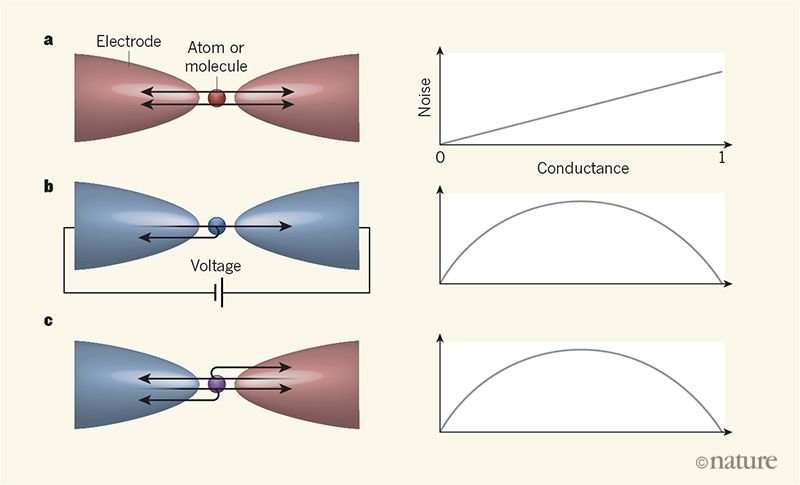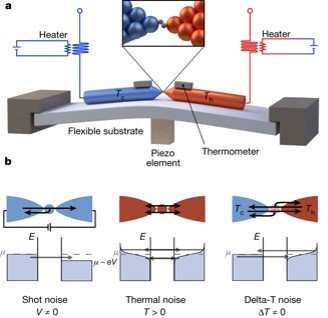October 30, 2018 feature
Electronic noise due to temperature difference in atomic-scale junctions

Noise is a fundamental feature of any electrical measurement that calculates random and correlated signal fluctuations. Although noise is typically undesirable, noise can be used to probe quantum effects and thermodynamic quantities. Writing in Nature, Shein Lumbroso and co-workers now report a new type of electronic noise discovered to be distinct from all other previous observations. Understanding such noise can be essential to design efficient nanoscale electronics.
More than a century ago, in 1918, German Physicist Walter Schottky published a paper describing causes and manifestations of noise in electrical measurements. In the publication, Schottky showed that an electric current produced by an applied voltage was noisy, even at absolute zero temperature, when all random heat-induced motion had stopped. The noise was a direct consequence of quantized electric charge that arrived in discrete units. The noise was termed 'shot noise,' as it resulted from the granularity of the charge flow.
In systems that are in thermal equilibrium, noise with distinctly different properties from shot noise came into play at non-zero temperatures known as Johnson-Nyquist noise. Shot noise is now a key tool to characterize nanoscale electrical conductors, since it contains information on quantum-transport properties that cannot be revealed via mere electric-current measurements.
In the study, the authors studied junctions composed of single atoms or molecules suspended between a pair of gold electrodes. The electrodes were fabricated by breaking a thin gold wire into two parts and bringing them gently back in to contact. In this process, hydrogen molecules were evaporated onto the device, known as a mechanically controllable break junction, to capture individual atoms or molecules between the electrode tips and establish an electrical contact.

A single-quantum mechanical transport channel constituted the resulting junctions wherein electrons could be transmitted from one electrode to the other. The probability of electron transfer could be adjusted by varying the openness of the channel. An ideal test bed setup was thus provided to explore the properties of noise contribution so far overlooked. When a temperature difference was applied between the two electrodes, the authors observed a strong increase in electronic noise compared with electrodes at the same temperature. The new noise, termed 'delta-T noise,' scaled with the square of the temperature difference, exhibiting similar dependence on electrical conductance as shot noise.
The findings of the study were explained via the quantum theory of charge transport known as Landauer theory, developed in the past few decades. The theory included both shot noise and thermal noise for intensive testing at the atomic and molecular scale. The theory accurately described many experimental observations when working entirely in thermal equilibrium or when applying small voltages.
On closer inspection of the theory, the authors observed that inclusion of a noise component only occurred when a temperature difference was solely applied across a junction as experimentally observed with delta-T noise. In the absence of an applied voltage, an electric current can arise due to a temperature difference via a phenomenon termed the Seebeck effect. According to the study, the delta-T noise arose from the discreteness of the charge carriers mediating the heat transport.
Although the Landauer theory is widely used, surprisingly, delta-T noise was not previously observed. The present work therefore conveyed a key message that careful experimental design and rigorous analysis are required to study the details of quantum transport. In practice, quantum-transport experiments that weren't entirely in thermal equilibrium could show strongly enhanced noise, which could be mistaken for noise arising from interactions between charge carriers or due to subtle effects. Unexpectedly high noise in electric-current measurements could be due to unintentional temperature gradients in experimental setups. In practice, the authors' work can potentially be used to detect undesirable hot spots in electrical circuits.
Future experimental focus will explore the relationship between delta-T noise and shot noise, with a nonlinear dependence on applied voltage. This phenomenon was recently observed in high-voltage experiments at atomic junctions. In combination with thermal noise, delta-T noise can be used as a probe for temperature differences in nanoscale systems. Delta-T noise is a versatile probe compared to physical sensors, not limited to a particular setup range, and that can be applied to conductors of variable sizes, including those at the atomic scale. The versatility allows delta-T noise to become an attractive tool for heat management, which includes thermoelectricity, heat pumping and heat dissipation, important for energy saving and sustainable energy production. Since temperature gradients are often unintentionally produced in electronic circuits, to prevent performance-limiting effects of delta-T noise, the temperature gradients should be minimized. The sensitivity of delta-T noise on the properties and interactions of charge carriers could become a valuable tool in quantum-transport.
More information: Ofir Shein Lumbroso et al. Electronic noise due to temperature differences in atomic-scale junctions, Nature (2018). DOI: 10.1038/s41586-018-0592-2
Elke Scheer et al. Unexpected noise from hot electrons, Nature (2018). DOI: 10.1038/d41586-018-06932-x
A. Hamo et al. Electron attraction mediated by Coulomb repulsion, Nature (2016). DOI: 10.1038/nature18639
Journal information: Nature
© 2018 Science X Network



















